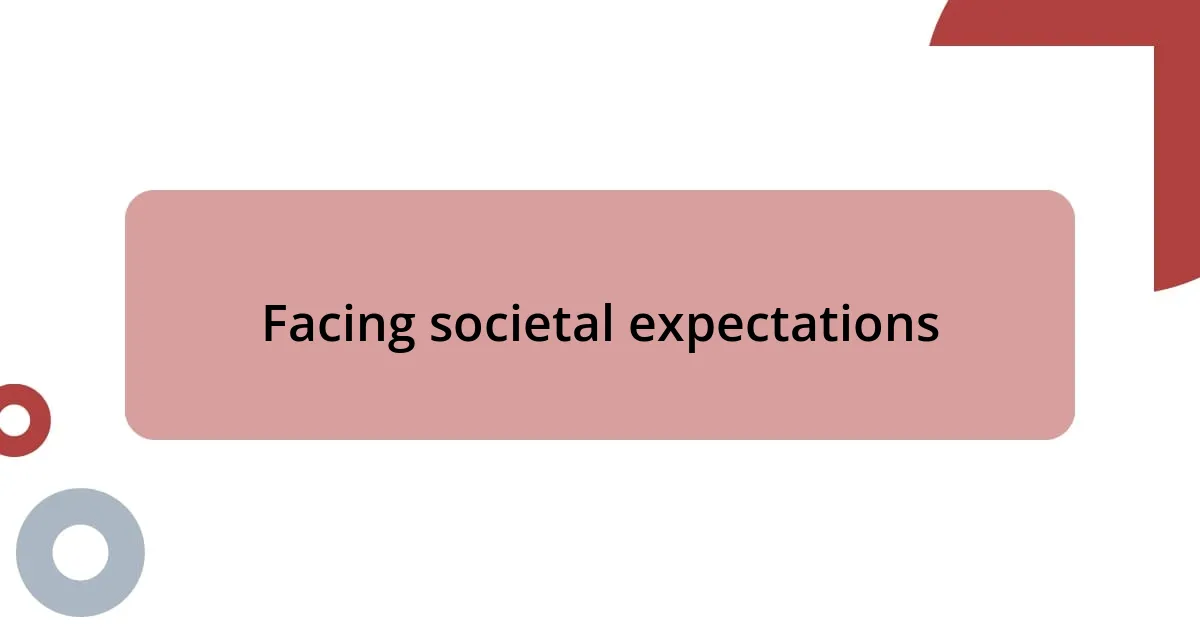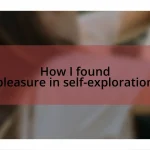Key takeaways:
- Understanding sexual identity involves introspection and self-acceptance, which often leads to embracing change.
- Supportive communities and open conversations with loved ones are crucial for personal growth and empowerment.
- Overcoming internalized stigma requires self-compassion and positive affirmations, fostering a journey toward authenticity.
- Living authentically can inspire transformation in others, creating a ripple effect of acceptance and love.

Understanding sexual identity
Understanding sexual identity is a deeply personal journey that varies significantly from one individual to another. I remember grappling with my feelings in high school, often feeling like a puzzle piece that didn’t quite fit in its designated spot. Have you ever felt that disconnect between how you perceive yourself and how the world sees you?
For many, the path to understanding starts with introspection. I took time to reflect on my experiences and feelings, realizing that my identity wasn’t just about labels; it was about how I felt at my core. It’s fascinating—how many of us seek acceptance in society when the real challenge is accepting ourselves first?
I’ve found that sexual identity can often be fluid. As I explored different relationships, I discovered facets of myself that I hadn’t recognized before. Isn’t it incredible how each experience shapes our understanding and contributes to who we are becoming? Understanding sexual identity is, at its heart, about embracing change and being open to the journey.

The journey of self-discovery
The journey of self-discovery often feels more like a winding road than a straight path. I vividly remember my first crush—an eye-opening moment when I realized my attraction didn’t conform to societal norms. It was exhilarating yet terrifying to confront those feelings, sparking a mix of excitement and fear that turned my world upside down.
As I navigated my emotions, certain moments stood out, teaching me invaluable lessons about identity. Here are some key insights from my experience:
- Embrace vulnerability: Opening up to friends about my feelings helped me shed layers of fear and judgment.
- Seek supportive communities: Finding spaces where others shared their stories made me feel less alone in my discovery.
- Practice self-compassion: It’s okay to make mistakes or feel uncertain; these moments are part of the learning process.
- Reflect on your experiences: Journaling my thoughts allowed me to see connections between my past and my evolving identity.
- Celebrate small victories: Whether it was coming out to a friend or simply accepting a part of me, recognizing these steps fueled my confidence.

Facing societal expectations
Facing societal expectations can feel like standing at a crossroads, with one path leading to conformity and the other to authenticity. I’ll never forget the pressure I felt, particularly during family gatherings, when the topic of relationships would arise. My heart raced as I watched relatives discuss their conventional love stories, knowing mine was different. Have you ever been caught in a similar moment, torn between your truth and the comfort of fitting in?
Navigating societal norms often meant wrestling with obligatory roles. I distinctly recall a friend of mine who, after coming out, faced disbelief from peers. It was heart-wrenching to see someone so brave confronted by the very expectations designed to protect the status quo. I learned that while society may impose limitations, embracing oneself can shatter those barriers. Have you ever felt the exhilaration of defying norms, even if just for a moment?
The contrast between societal expectations and personal authenticity can be stark. I encountered moments of joy when I found acceptance among friends who embraced my journey. Each time I shared my truth, it felt like peeling away layers of an old skin, revealing a version of myself that had long been hidden. Isn’t it remarkable how stepping into the light of our true selves can inspire others to do the same?
| Societal Expectations | Personal Experience |
|---|---|
| Conformity to norms | Faced pressure to maintain an image |
| Maintaining the status quo | Defined by love stories that didn’t resonate with my truth |
| Reactions from others | Experienced both skepticism and warmth from friends and family |
| Challenges in authenticity | Felt torn between acceptance and self-expression |

Finding supportive communities
Finding the right supportive community was a game-changer for me. I remember the first time I stepped into a local LGBTQ+ group meeting—I felt a mix of anxiety and hope. Listening to others share their stories and struggles was so validating. Has there ever been a moment when you realized you weren’t alone in your experiences? There’s something incredibly powerful about knowing others have walked a similar path.
Over time, I connected with people who not only understood my journey but also celebrated it. I often think back to a friend I made at one of those meetings; they became both a confidant and a source of inspiration. Sharing our stories not only helped me to embrace my identity but also deepened my connection with them. Have you ever had a friendship that lifted you in ways you never expected? For me, those relationships felt like a warm embrace, reminding me that acceptance and understanding exist in abundance.
Building a supportive community isn’t just about finding like-minded individuals—it’s also about creating a safe space for vulnerability. I initiated a small book club focused on LGBTQ+ literature, which transformed my experience of self-discovery into something communal. When the conversations flowed, I felt an overwhelming sense of belonging. Have you ever felt that rush of joy when speaking your truth? It’s these moments of shared connection that solidified my path and deepened my resolve to live authentically.

Open conversations with loved ones
Opening up to loved ones about my sexual identity was a pivotal moment in my life. I remember inviting my closest friends over for what I can only describe as a “truth-telling” night. I felt a surge of vulnerability as I shared my journey, but the warmth and acceptance in their reactions transformed my fear into empowerment. Have you ever felt that rush when you let go of the burden of secrecy, only to find open arms waiting on the other side?
Having candid conversations with family was different, though. One chilly evening, I sat my parents down, clutching a pillow like a lifeline. Their initial silence felt like an eternity, but slowly, their understanding blossomed into supportive dialogue. It reminded me that sometimes, the hardest conversations can lead to the most profound connections. Have you ever experienced that moment of silence before the storm of emotions reveals a deeper bond?
These conversations didn’t just liberate me; they sparked a ripple effect. I discovered that sharing my experience encouraged others to voice their truths, too. A cousin confided in me about her struggles with societal pressure, and it struck me how interconnected our journeys really are. Isn’t it inspiring how our willingness to be open can foster deeper ties and encourage those we love to embrace their true selves?

Overcoming internalized stigma
Overcoming internalized stigma was an uphill battle for me. There were days when I was my own worst critic, fueled by feelings of shame and doubt. I vividly remember looking in the mirror and asking, “Why can’t I just be like everyone else?” It was a painful realization that these thoughts weren’t just my own; they were echoes of societal pressures that I had absorbed over time.
As I began acknowledging this internal conflict, I found solace in writing my feelings down. Journaling became a therapeutic outlet where I could untangle the messy web of fear and self-doubt. One particular entry stands out: I penned a letter to my past self, filled with compassion and understanding. It was a powerful moment of self-reclamation that helped me confront the stigma I had internalized. Have you ever found that identifying your feelings can help diminish their power over you?
Gradually, I learned to replace negative self-talk with affirmations that celebrated my identity. Every time I caught myself slipping into that old narrative, I would remind myself, “You are worthy of love and acceptance, just as you are.” This shift didn’t happen overnight, but with patience and practice, I discovered a newfound strength within. Think about it; when was the last time you looked at yourself through a lens of love instead of judgment? Overcoming internalized stigma can be a transformative journey, inviting you to embrace the entirety of who you are.

Living authentically and proudly
Living authentically meant shedding the masks I’d worn for so long. One afternoon, I decided to wear an outfit that truly expressed my style, rather than what I thought others would accept. The nervousness of stepping outside was palpable, but as the sun hit my face, I realized that the freedom of being true to myself outweighed my fears. Have you ever had that exhilarating moment when you felt like you were finally showing the world who you really are?
I vividly remember attending a pride event for the first time. The atmosphere was electric, filled with a mix of laughter, music, and heartwarming acceptance. As I joined in the celebration, I felt a profound sense of belonging I had long yearned for. Surrounded by people who embraced their identities with such courage, I thought, “What if I had experienced this sense of community sooner?” That day not only affirmed my identity but also inspired me to live out loud, unapologetically.
Embracing my authentic self also shifted my relationships. Friends noticed the change in my energy, and they responded by becoming more open and genuine themselves. I found that when I lived proudly and authentically, it encouraged those around me to do the same. How powerful is it that our true selves can spark transformation in others? It’s like igniting a chain reaction of authenticity and love, creating a space where everyone feels they can express who they truly are.














